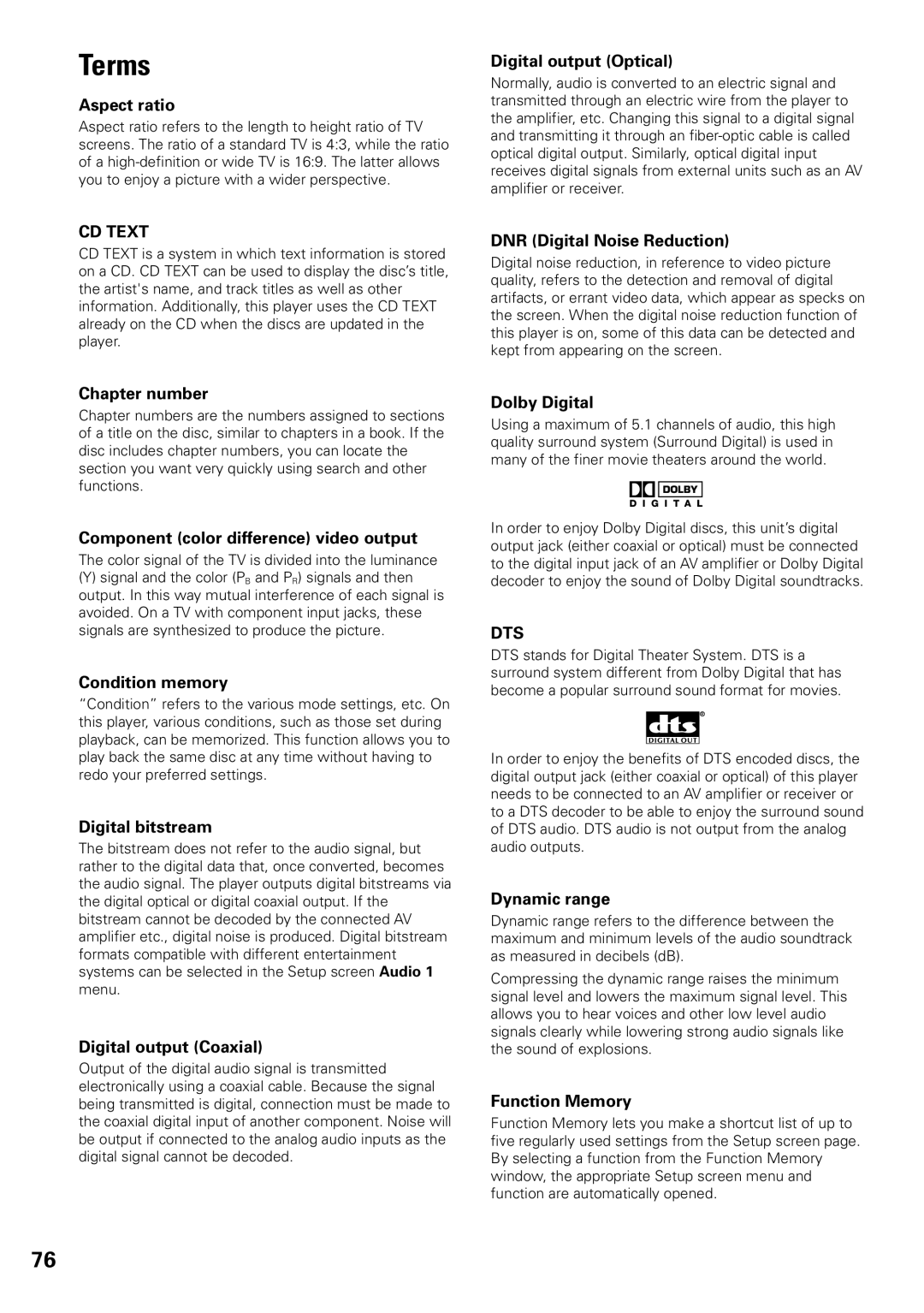Terms
Aspect ratio
Aspect ratio refers to the length to height ratio of TV screens. The ratio of a standard TV is 4:3, while the ratio of a
Digital output (Optical)
Normally, audio is converted to an electric signal and transmitted through an electric wire from the player to the amplifier, etc. Changing this signal to a digital signal and transmitting it through an
CD TEXT
CD TEXT is a system in which text information is stored on a CD. CD TEXT can be used to display the disc’s title, the artist's name, and track titles as well as other information. Additionally, this player uses the CD TEXT already on the CD when the discs are updated in the player.
DNR (Digital Noise Reduction)
Digital noise reduction, in reference to video picture quality, refers to the detection and removal of digital artifacts, or errant video data, which appear as specks on the screen. When the digital noise reduction function of this player is on, some of this data can be detected and kept from appearing on the screen.
Chapter number
Chapter numbers are the numbers assigned to sections of a title on the disc, similar to chapters in a book. If the disc includes chapter numbers, you can locate the section you want very quickly using search and other functions.
Component (color difference) video output
The color signal of the TV is divided into the luminance
(Y)signal and the color (PB and PR) signals and then output. In this way mutual interference of each signal is avoided. On a TV with component input jacks, these signals are synthesized to produce the picture.
Condition memory
“Condition” refers to the various mode settings, etc. On this player, various conditions, such as those set during playback, can be memorized. This function allows you to play back the same disc at any time without having to redo your preferred settings.
Digital bitstream
The bitstream does not refer to the audio signal, but rather to the digital data that, once converted, becomes the audio signal. The player outputs digital bitstreams via the digital optical or digital coaxial output. If the bitstream cannot be decoded by the connected AV amplifier etc., digital noise is produced. Digital bitstream formats compatible with different entertainment systems can be selected in the Setup screen Audio 1 menu.
Digital output (Coaxial)
Output of the digital audio signal is transmitted electronically using a coaxial cable. Because the signal being transmitted is digital, connection must be made to the coaxial digital input of another component. Noise will be output if connected to the analog audio inputs as the digital signal cannot be decoded.
Dolby Digital
Using a maximum of 5.1 channels of audio, this high quality surround system (Surround Digital) is used in many of the finer movie theaters around the world.
1
In order to enjoy Dolby Digital discs, this unit’s digital output jack (either coaxial or optical) must be connected to the digital input jack of an AV amplifier or Dolby Digital decoder to enjoy the sound of Dolby Digital soundtracks.
DTS
DTS stands for Digital Theater System. DTS is a surround system different from Dolby Digital that has become a popular surround sound format for movies.
In order to enjoy the benefits of DTS encoded discs, the digital output jack (either coaxial or optical) of this player needs to be connected to an AV amplifier or receiver or to a DTS decoder to be able to enjoy the surround sound of DTS audio. DTS audio is not output from the analog audio outputs.
Dynamic range
Dynamic range refers to the difference between the maximum and minimum levels of the audio soundtrack as measured in decibels (dB).
Compressing the dynamic range raises the minimum signal level and lowers the maximum signal level. This allows you to hear voices and other low level audio signals clearly while lowering strong audio signals like the sound of explosions.
Function Memory
Function Memory lets you make a shortcut list of up to five regularly used settings from the Setup screen page. By selecting a function from the Function Memory window, the appropriate Setup screen menu and function are automatically opened.
76
